St Bernard's
Formed 1878. Wound up 1943.
Elected to Scottish Division One 1893. Transferred to the Eastern League 1915.
Founder member of the reformed Scottish Division Two 1921. Resigned 1943.
Kit History
3rd Edinburgh Rifle Volunteers
1874-1880
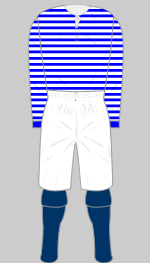
1874 g
St Bernard's
1878
Formed as an offshoot of 3rd Edinburgh Rifle Volunteers
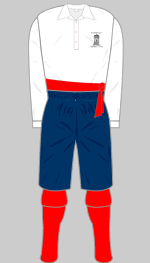
1878-1887 c d
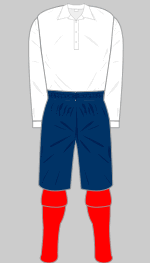
1887-1892 f
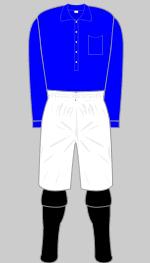
1892-1899 c d f h
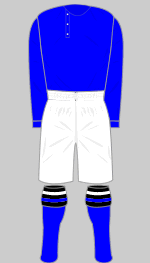
1899-1900 e
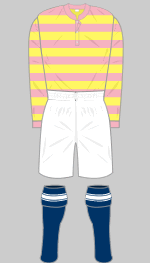
1900-1903 f
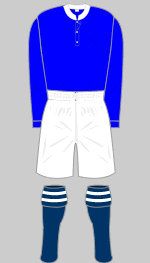
1906-1907 h
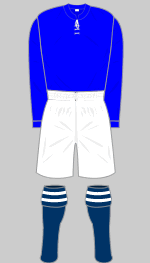
1907-1908 h
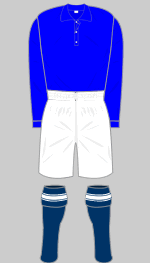
1910-1911 c d f
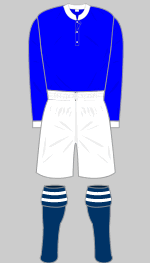
1912-1920 f
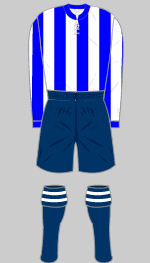
1920-1921 i

1921-1922 i
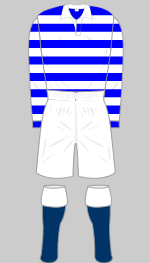
1924-1931 f
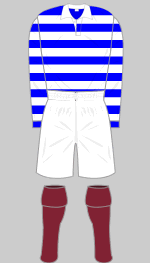
1931-1940 a c d f
Background
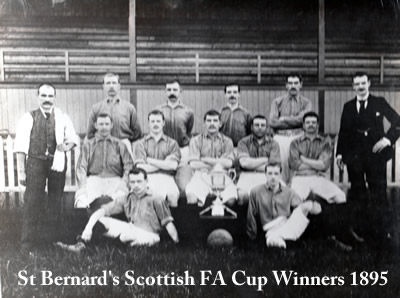 In late 1873 Queen’s Park and Clydesdale, played an exhibition match in Edinburgh. Among the spectators were members of the Third Edinburgh Volunteer Rifle Corps, a part-time regiment that offered young working men military training who resolved to form a team of their own.
In late 1873 Queen’s Park and Clydesdale, played an exhibition match in Edinburgh. Among the spectators were members of the Third Edinburgh Volunteer Rifle Corps, a part-time regiment that offered young working men military training who resolved to form a team of their own.
As the game grew in popularity and the team achieved success (winning the East of Scotland Shield in 1876) some of the players decided to concentrate on football rather than soldiering and broke away to form St Bernard’s FC in 1878, taking their name from St Bernard’s Well in the district of Stockbridge. An image of the famous landmark was worn on their original shirts as a badge. In 1880 the club became members of the Scottish Football Association and move into The Royal Patent Gymnasium Grounds, known as “The Gymmie.” The Gymnasium was one of the wonders of the age, offering a range of healthy pastimes including a giant “rotary boat” that could accommodate up to 60 rowers at a time.
The club grew in stature and several players were induced to join English clubs such as Accrington and Preston North End. In 1889 the Saints moved from the cramped “Gymmie” to Logie Green and adopted plain blue jerseys. That same year they were suspended for 12 months by the Scottish FA following allegations that they had paid players (“professionalism” would not be recognised in Scotland until 1893). The club survived this setback and continued to play friendly matches thinly disguised as "Edinburgh Saints." The following season they joined the Scottish Alliance.
After two impressive seasons, St Bernard’s turned professional and, along with Dundee were rewarded with a place in Scottish Division One at the expenses of Abercorn and Clyde, who were placed in the newly formed Second Division. Saints made an immediate impact, finishing third, an achievement they would never surpass.
In 1895, Edinburgh dominated senior Scottish football. Hearts won the First Division title, Hibernian were Second Division champions and St Bernard’s beat Renton to win the Scottish Cup. This proved to be the high water mark for the club: when their best players were tempted away to join professional teams in England and Glasgow, they were unable to build on success and in 1900 they lost their place in the First Division, never to regain it. For a few seasons they adopted the primrose and pink racing colours of the Earl of Rosebery, a former leader of the Liberal Party and, briefly, Prime Minister. (The national team also played in his colours around this time). In 1903, with the club again playing at “The Gymmie,” their main benefactor, William Lapsley, was killed when the horse pulling his cab bolted.
In 1915, St Bernard’s finished in joint first place with Cowdenbeath and Leith Athletic and took part in a three-way “play-off” to decide the championship, only to lose out to Cowdenbeath. The Second Division was then suspended for the duration of the Great War and St Bernard’s, after playing on for another season in the eastern League, closed down in 1916.
St Bernard’s returned to the Scottish League when the Second Division was reinstated in 1921. The Gymnasium was unplayable, having been used by the Army during the war, and it was not until 1922 that the War Office offered compensation. It took another two years to bring the ground up to standard and the Saints played their home matches at Hearts' Tynecastle ground during this period. Around February 1931 a former Hearts player presented the club with a set of maroon stockings, which became part of their regular kit.
Rarely out of the bottom six, St Bernard’s narrowly avoided relegation to the oblivion that was the new Division Three. In 1938 they reached the semi-final stage of the Scottish Cup only to lose to fellow Second Division side East Fife in a second replay. (East Fife went on to become the only Second Division side to have won the Scottish Cup.)
In 1939, The Scottish League closed down with the outbreak of the Second World War. In 1943 the club suffered a financial crisis. With no source of income or capital, St Bernard’s had no alternative but to sell off their remaining assets and the club ceased to exist.
In 1949 the name of St Bernard's was revived with the formation of a youth team, which has survived and expanded to this day.
Based on articles by John Byrne available on the The Scottish Football Historians Association website.
Sources
- (a) Relichtie Plus
- (b) London Hearts
- (c) The Scottish League Former Members (Norman Nichol 1992)
- (d) Historic Saints of Edinburgh (George Campbell 1983) provided by Stuart Swan
- (e) Dundee FC - Images of Sport (Paul Lunney 2001)
- (f) Alick Milne
- (g) Scottish Football History
- (h) St Bernard's FC - website of the modern club
- (i) The Vision Book of Football Records by Clive Batty (Vision Sports Publishing 2009 ISBN 978 1905326 68 6)
Photograph courtesy of St Bernard's FC provided by George Park, author of St Bernard's Football Club or When the Well Ran Dry! available from 15 Royal Crescent, Edinburgh, EH3 6QA for £7.25 inclusive of postage & packaging (cheques payable to CCLASP).